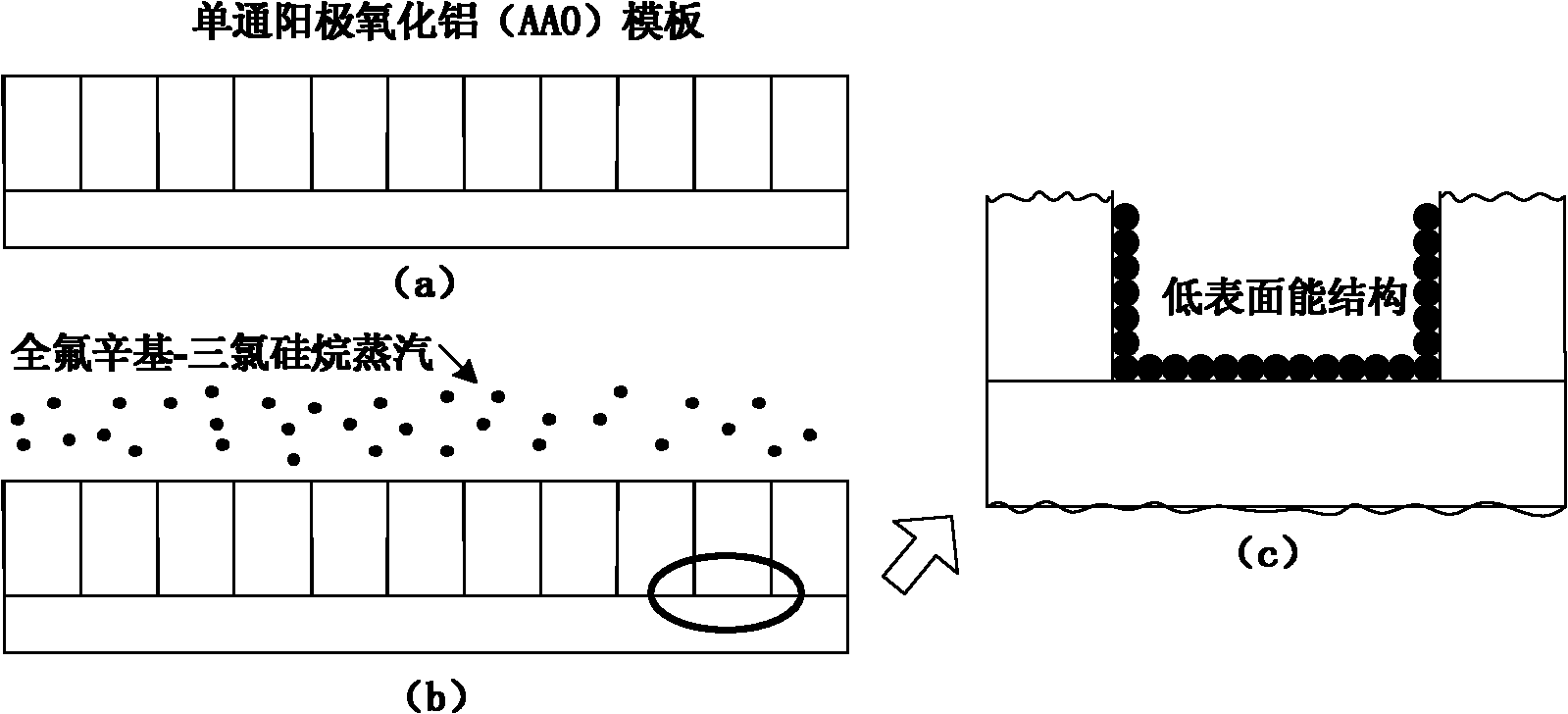Preparation method of nanoimprint hard templates
A technology of nano-imprinting and hard template, applied in the direction of photo-engraving process of pattern surface, opto-mechanical equipment, originals for opto-mechanical processing, etc., can solve the problems of low efficiency, unrealistic, fragile and so on
- Summary
- Abstract
- Description
- Claims
- Application Information
AI Technical Summary
Problems solved by technology
Method used
Image
Examples
Embodiment 1
[0031] 1. First, a two-step electrochemical anodization method is used to prepare a regular anodized aluminum AAO template with adjustable size, ie, pore diameter, pore spacing, and pore depth, in a 0.1-0.5mol / L oxalic acid solution. The anode voltage is 40-50V. The temperature is 0-15°C, the first oxidation time is 2 hours, and the second oxidation time is 3-5 minutes. 3 PO 4 Reaming is carried out in the middle, and the AAO template of the required size is obtained as figure 1 as shown in (a);
[0032] 2. Next, under a standard atmospheric pressure and normal temperature, vapor-deposit the AAO template in the vapor atmosphere of perfluorooctyl-trichlorosilane for 80 to 100 minutes, and then bake it at 100°C for 13 to 15 minutes. A dense layer of organic molecules is formed, and this thin film makes the surface of the template have a very low surface energy, about 12 dynes / cm. figure 1 (b) is a schematic diagram of evaporation, figure 1 (c) is a schematic diagram of a low...
Embodiment 2
[0039] 1. First, a two-step electrochemical anodization method is used to prepare a regular anodized aluminum AAO template with adjustable size, ie, pore diameter, pore spacing, and pore depth, in a 0.1-0.5mol / L oxalic acid solution. The anode voltage is 40-50V. The temperature is 0-15°C, the first oxidation time is 2 hours, and the second oxidation time is 3-5 minutes. 3 PO 4 Reaming is carried out in the middle, and the AAO template of the required size is obtained as figure 1 as shown in (a);
[0040] 2. Next, under a standard atmospheric pressure and normal temperature, vapor-deposit the AAO template in the vapor atmosphere of perfluorooctyl-trichlorosilane for 80 to 100 minutes, and then bake it at 100°C for 13 to 15 minutes. A dense layer of organic molecules is formed, and this thin film makes the surface of the template have a very low surface energy, about 12 dynes / cm. figure 1 (b) is a schematic diagram of evaporation, figure 1 (c) is a schematic diagram of a low...
Embodiment 3
[0047] 1. First, a two-step electrochemical anodization method is used to prepare a regular anodized aluminum AAO template with adjustable size, ie, pore diameter, pore spacing, and pore depth, in a 0.1-0.5mol / L oxalic acid solution. The anode voltage is 40-50V. The temperature is 0-15°C, the first oxidation time is 2 hours, and the second oxidation time is 3-5 minutes. 3 PO 4 Reaming is carried out in the middle, and the AAO template of the required size is obtained as figure 1 as shown in (a);
[0048] 2. Next, under a standard atmospheric pressure and normal temperature, vapor-deposit the AAO template in the vapor atmosphere of perfluorooctyl-trichlorosilane for 80 to 100 minutes, and then bake it at 100°C for 13 to 15 minutes. A dense layer of organic molecules is formed, and this thin film makes the surface of the template have a very low surface energy, about 12 dynes / cm. figure 1 (b) is a schematic diagram of evaporation, figure 1 (c) is a schematic diagram of a low...
PUM
 Login to View More
Login to View More Abstract
Description
Claims
Application Information
 Login to View More
Login to View More - R&D
- Intellectual Property
- Life Sciences
- Materials
- Tech Scout
- Unparalleled Data Quality
- Higher Quality Content
- 60% Fewer Hallucinations
Browse by: Latest US Patents, China's latest patents, Technical Efficacy Thesaurus, Application Domain, Technology Topic, Popular Technical Reports.
© 2025 PatSnap. All rights reserved.Legal|Privacy policy|Modern Slavery Act Transparency Statement|Sitemap|About US| Contact US: help@patsnap.com



